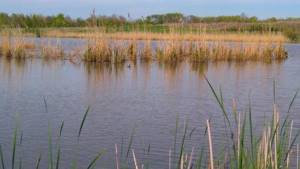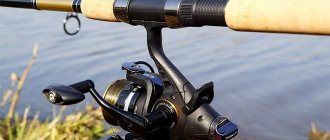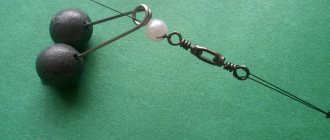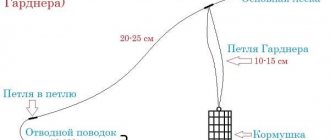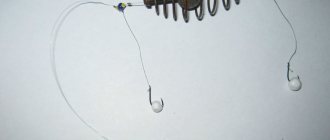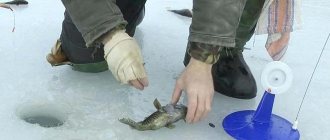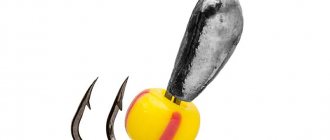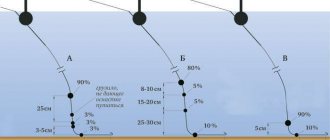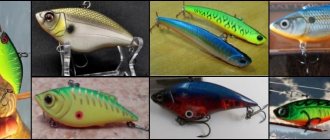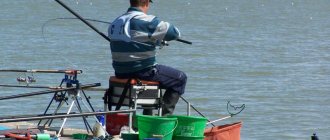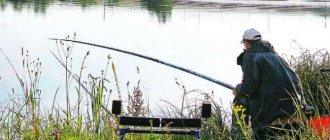Home > Spring fishing > Feeder fishing in spring - places, bait and equipment
In the spring, when the water opens, the fish awakens and begins to be active in searching for food. This is where the feeder shows itself. With the help of a feeder, bait can be delivered over a long distance and kept on the bait spot for a long time.
In the spring before spawning, the feeder has an advantage over other gear. The fish is looking for a place to spawn and, going upstream, is far from the shore. Only a good feeder rod can reach it.
When to start spring fishing
Let's start with the fact that winter can be different, just like spring. Therefore, we do not have clear boundaries and frameworks other than the calendar sheet. We will build on annual statistics in central Russia. I myself live in the city of Kaluga and in the spring I try to devote my free time to fishing in my native reservoirs.
Rivers are the first to open up from the ice cover, followed by stagnant bodies of water. My first spring fishing trips begin on my beloved Oka. If the winter was not snowy, like, for example, 2019/20, then the flood will be minimal, or there may not be any. Nevertheless, the lower the flood, the sooner the feeders are unpacked - this is a fact.
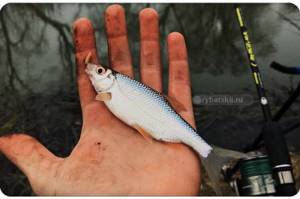
Useful tips
- When buying branded bait mixtures in a store or market, choose proven products from well-known brands.
- Avoid brightly colored bait, which is not typical for our reservoirs.
- When kneading the mixture, do not rush, let it soak thoroughly.
- Be sure to add a worm, maggot, or bloodworm to your bait; this will help keep the bream in place.
- Add flavorings last. If these are spices, it is better to grind them right at the fishing spot.
- Do not use unnatural fragrances.
- Do not use attractants with sweet odors in wild ponds and lakes.
- To mix the mixture, use water from the reservoir where you plan to hunt bream.
- Do not forget that the bait for bream in the spring at home for the feeder must necessarily include adhesives that will not allow the mixture to crumble immediately after entering the water.
- When feeding a place, do not overdo it, because our task is to attract, not feed, bream.
Ban
For each region, the timing of the spawning ban is determined differently. It all depends on the type of reservoir, type of fish and temperature conditions. And also in some areas it is prohibited to fish all year round - these are wintering pits. For example, in the Kaluga region in the spring there are two main prohibitions:
- From April 1 to June 10 - with all fishing gear, with the exception of one float or bottom fishing rod from the shore, with a total number of hooks of no more than 2 pieces.
- From October 1 to April 1, it is prohibited to fish in wintering pits.
Preparing for the opening of the season
It is imperative to prepare for spring feeder fishing; there are already plenty of people here. It’s more practical to do this on long winter evenings, but if you suddenly don’t have time, it doesn’t matter. Think carefully about what is missing and buy it.
In spring or winter, do not buy food in fishing stores, because there is a high probability of running into expired or rancid food. It would be better to purchase from official dealers, as I do.
Check the quality of the fishing line and cord if you did not change them after the season closed, if, of course, you closed it.
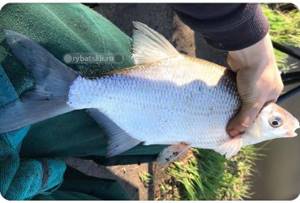
All spring processes begin in March, be it the beginning or the end of the month. Of course, there are frosts in March, but most likely they are the last. I believe that March is the best month to open the season for feeder fishing lovers. During this month, you can usually find open areas to enjoy fishing after a long break. You shouldn't count on a good catch, but there are always exceptions.
After the ice drift, the river comes alive with new colors. The first insects emerge after a long hibernation, the sun gets hot, and the fish returns to its normal lifestyle. Spawning is ahead, and some species of fish have already spawned, it’s time to eat up for future use. In April it is worth staying on the river bank more often; during this period it is possible to catch any fish of different sizes. It is worth focusing on: chub, silver bream, bream and roach.
Bait for bream in spring at home
Experienced fishermen often prepare bait with their own hands. Knowing the reservoir and the feeding habits of bream in it, you can prepare a bait mixture with your own hands, which will not be inferior in effectiveness to branded products.
What is needed for this? You will need the ingredients listed above, dishes for steaming cereals and a coffee grinder for grinding some ingredients. To purchase the components necessary for the mixture, you will have to spend a little, but this amount will be several times less than what is asked for the finished product.
Any bait for bream in the spring at home should include additives of animal origin (worms, bloodworms, maggots), so don’t forget to look at the fishing store.
Choosing a fishing spot
In the spring, almost all fishing will depend on the choice of fishing location; this should be given much more attention than other factors. With the first warmth of spring, white fish, and not only others, begin to actively feed, when the water is still quite cold and has not had time to warm up, the diet of white fish consists of food of animal origin.
Around the end of April, try vegetable baits, for example, catching chub on corn. And also with the first warmth, the fish begin to emerge from cold and deep holes into warmer areas of the reservoir. I believe that some places are much more promising than others.

Look for shallow water areas with plenty of underwater vegetation. And also tie the choice of fishing location to the ground.
In spring, sand bars and shallows seem to attract fish like a magnet. Underwater inhabitants “go out” and clean themselves there from various parasites that have accumulated over the winter. The confluence of rivers, especially small ones, should be examined carefully. During the fish run, due to spawning, fishing in small rivers brings an excellent catch, but more often such places for fishing with a feeder are simply impassable and have many nuances. Or you may not get to this spring move at all, because, as usual, it lasts a short period and it’s great luck to get there. However, this fishing differs from classic feeder fishing.
Fishing on a feeder in spring for roach, bream, carp, crucian carp
Roach
You can catch roach as soon as the water melts. Of course, you shouldn’t count on an intense bite, but with gradual warming, the activity of roach will increase. In early spring, fishing with a feeder will be successful in shallow water areas near last year’s reeds, flooded bushes or snags, which the roach will use as shelter, and the depth here can be only half a meter. But the roach will avoid places where there is no shelter and a light bottom, giving preference to areas with a dark bottom. During floods, the roach goes a little deeper, but even here the depth is no more than 1.5-2 meters. With gradual warming, the roach moves to deeper water areas.
On rivers, roach migrate to spawning grounds; here it is more effective to fish in areas where the current loses its strength (backwaters, oxbow lakes), and the depth should be at least two meters.
Bream
Fishing for bream on a feeder in the spring is not as effective as in the summer; now it is just beginning to recover from the cold, leaving its wintering pits and moving closer to the shore to depths of 2 to 5 meters. The lump chooses areas with an uneven bottom and adjacent plains, popularly called “bream tables.” The places we need are formed near river beds, and the current washes onto them food that was washed into the river during the spring flood. And the water here is warmer than on the main stream.
In early spring, bream can be found at the mouths of small rivers, as the water here warms up faster. You can also find bream in shallows 1-1.5 m deep.
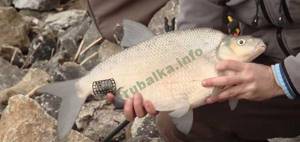
.
Carp
On ponds, carp fishing with a feeder in the spring is primarily successful in places about 2 meters deep. In bodies of water with a current, carp choose bays and backwaters. With gradual warming, carp go to ever greater depths.
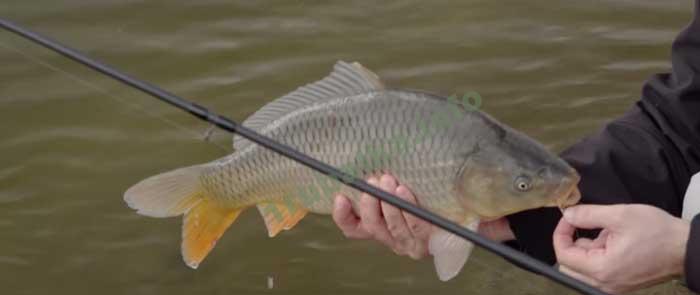
In stable warm weather, carp can be found near holes covered with shells and rich in algae with young shoots.
crucian carp
In the spring, crucian carp begin to bite when the water warms up to 6-7 degrees, while the bite is rather sluggish. You should look for crucian carp in shallow water; an excellent option would be a bay protected from the wind; here crucian carp can be found near submerged logs, snags at the edge of reeds and in places where there is aquatic vegetation. In shallow water, crucian carp behaves very warily and the fisherman's fuss on the shore can scare it away, so many fishermen throw the tackle under the opposite shore.
Preparing gear and choosing equipment
After we have chosen a promising fishing spot, we move on to the fishing gear. This is one feeder with a rod test suitable for your fishing conditions. On the Oka River in the Kaluga region there is a huge variety of places in terms of relief and strength of current.
Let me give you a simple example: in one place there is a feeder weighing fifty grams, and downstream about a hundred meters, it is already difficult to keep a feeder weighing one hundred and twenty grams at the point. Therefore, it makes no sense to advise anything on the rod test; these parameters are selected individually. For river fishing, I use a heavy feeder with dough up to one hundred and twenty grams with large, through-flow rings. I recommend using a traction reel, with a gear ratio of 4.7:1, plus or minus, spool size 4000–5000.

I recommend using monofilament as the main fishing line; 0.25-0.29 mm in diameter is suitable, for example, Dunaev Feeder Match. I'll explain why. At the beginning of spring, an abundance of debris floats on the rivers, including grass, which constantly sticks to the cord and equipment in general. The fishing line reduces the sticking of grass several times, and large guide rings on the feeder prevent breakage of the quiver tip and prevent problems with fishing.
To be honest, in the spring I don’t consider any rig better than another; I’ll say more, I prefer to choose a rig for fish and current. For fishing in strong currents, as well as on a longline, the “helicopter and two knots” installation is suitable.
Universal installation at any time of the year, especially for passive fish, is considered a “Gardner loop”.
I don’t recommend shredding with hooks and lead line. In the spring, a variety of fish may drop by. It’s another matter if the fish refuses to accept a rough feed, but this is more of a special case. For active fishing for silver bream and roach on the river, meter-long leashes of 0.10-0.12, fishing line with hook numbers 12,14,16, OWNER 53101, 100 are suitable, I consider this combination a panacea.
Subtleties of spring feeding
Often, the success of fishing depends not only on the selected bait composition and its quantity. Other factors also play an important role: fishing location, time of day, weather, delicacy of gear and installation.

Feeder volume
This parameter is especially important when fishing with a feeder or bait. Unlike the warm season, starting feeding is not used in the spring. Cold water does not allow the fish to eat much, so the volume of the feeder should be minimal.
Many anglers use closed models, but the large amount of animal feed that is added to the spring composition does not pass through the fine mesh well. The feeder should be open on both sides. The frequency of re-rolls also increases. 15-20 minutes is enough for inactive fish to approach the bait.
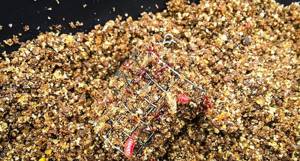
Catching distance
It is no secret that the same composition works completely differently in still water and in flowing water. As a rule, the middle of the river is the channel where there is a strong current. In such places there is no point in using weightless mixtures; they are carried away too quickly by the flow. You can make the bait heavier using broken clay or sifted soil from a molehill. This technique is also used in places with a depth of 4 meters.
Read: Baits and aromatic additives for carp fishing
Having chosen a fishing location, you need to identify several promising areas for yourself. At the beginning of spring, schools of roach and bream, crucian carp and crucian carp come out to the shallows, to the boundaries of vegetation, to soak up the sun.
In early spring, the fish approaches the shore, so you can fish not only with feeder tackle, but also with float rigs using Bolognese or fly rods.
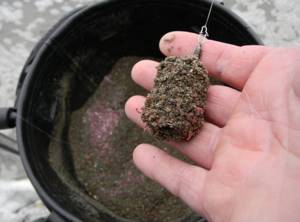
Application of pellets
This technique has found its way among sports fishermen. Its essence is to throw a small pinch of granules at the fishing point every 5-10 minutes. Thus, you can accurately determine whether the fish responds to bait and whether this procedure gives results.
Pellets granules are rich in amino acids, fats and protein; they were first used to feed trout in private farms. Underwater, pellets perfectly increase the bite, releasing a subtle meaty aroma near the bait. The main thing is not to overdo it; 10 granules are enough for one cast.
Bait that works
As I mentioned initially, when fishing on a feeder for the first weeks of spring, bait of animal origin works better; our favorite, of course, is a worm, torn into 2-3 parts. But don’t forget about the combinations of multi-colored maggots and bloodworm larvae. On large fish, for example, ide, chub, the crawler shoots well. I didn’t notice any good results in cold water with vegetable baits and I can’t recommend anything specific. Perhaps in the last days of April and during May you can actively experiment with pearl barley, wheat, peas, corn and lupine.
Tactics and fishing techniques
Feeder fishing in the spring is active fishing.
Before fishing
- Making leashes of various lengths, at least two pieces each.
- Checking gear and tools.
- Checking the availability of feeders.
- Studying the condition of rods and rod rings.
- Checking the performance of the coils.
- Preparation of dry complementary foods.
Expert opinion
Knipovich Nikolai Mikhailovich
Zoologist, hydrobiologist. I am interested in fishing at a professional level.
Important! The old fishing line must be checked for breaking load by tying one end of the fishing line to a stationary object and the other end to a steelyard. By pulling the line with force until it breaks, we fix the breaking load on the steelyard.
On the spot
- Bringing the bait mixture to readiness.
- Preparing the fishing site.
- Gear assembly.
- Studying the bottom topography with a marker.
- Determination of the fishing point.
- Fixing the fishing distance with a clip on the reel.
- Making bait balls.
- Filling feeders with food.
Depending on the fishing distance, the method of delivering complementary food to the point is selected.
If it is impossible to throw in complementary food by hand, a feeding trough is used, which, like the working trough, will be delivered to the point using a feeder.
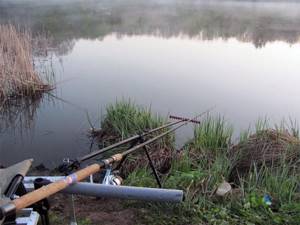
In early spring you will have to experiment intensively.
If the place is chosen well, then the arrival of small items will occur 5-10 minutes after casting, which will be signaled by the tip with a slight trembling. The arrival of large fish is expected in 30-40 minutes.
If this does not happen, you should not immediately leave the chosen place. The bite of small fish signals that a good place has been chosen, but large, cautious fish are afraid for some reason to take the bait.
The following actions should be performed in turn:
- choose a longer leash;
- change bait;
- add a coarse fraction to the bait;
- increase the interval between casts to 10 minutes.
If there is no result, you should experiment with the size and color of the hooks.
In early spring, upon leaving the wintering pits, the fish are still lethargic, capricious and cautious. Maybe:
- the wrong leader material was chosen. It's worth switching to fluorocarbon and experimenting with the length of the leader;
- The wrong consistency and density of the feed in the feeder has been selected. It is worth compacting, or vice versa, diluting the food with water;
- An insufficiently effective attractant was chosen that does not attract large individuals. It's worth experimenting with scents.
It is worth saying that in early spring you should not limit yourself to one fishing spot.
When fishing in the spring, it is better to take two or three feeders and, if there is no bite for a long time, move the feeders one by one to a new place, having first checked the bottom with a marker.
Choice of bait
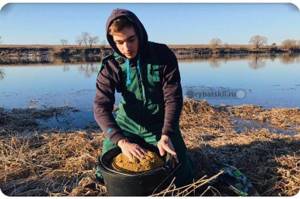
Many fishermen, especially the older generation, are inclined to believe that bait is irrelevant in the spring. I think differently, bait is needed, the only question is its main components. Whenever I mix a composition, I pay attention to the temperature of the water and go from there. From the beginning of March to mid-April, fine-grained bait with a slightly pronounced aromatic performance performs well. For example, notes of spices, anise, chocolate, as well as vanilla and coriander. But I think the important element is the animal component.
In the spring, groundbait mainly serves as a means of delivering livestock to the fishing point; food bloodworms are suitable. Starting from mid-April, start trying summer compositions; the water is sufficiently warmed up for active feeding of fish.
Feeder bait in spring
The composition and consistency of feeder bait is selected based on fishing conditions. The bait on the feeder in early spring is finely dispersed, dusty, and evenly disintegrates on the bottom. The fish cannot be overfed, but at the same time you need to somehow attract it to the point. Therefore, in the spring we add a little animal component to the mixture.
With warming, the fish can be fed more, gradually adding more nutritious elements - betaine, molasses, large feed particles. The aroma is spicy and animalic in cold water, sweet in warm water. In early spring, it is advisable to dilute the bait for the feeder with soil sifted through a sieve, in a proportion of 50%, in order to further reduce the number of nutrient particles, and leave the mechanics of work the same.
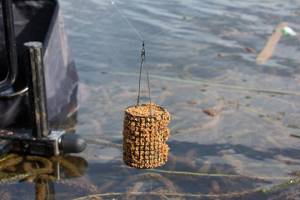
Both store-bought and homemade mixtures work. An excellent solution for a feeder is to use a homemade base, adding a little high-quality sports bait for aromatics when mixing.
Composition of a homemade base:
- Breadcrumbs, finely ground culinary waste.
- Ground sunflower cake.
- Oatmeal (rolled oats), bran. Powdered milk for turbidity (for roach).
- Ground granulated pork feed
We mix the ingredients in different proportions - each fisherman has his own recipe. It is important to achieve the desired consistency for the feeder when kneading by adding loosening or binding components. With the onset of warmth, we add large particles to the spring bait for the feeder - millet, corn, and more animal additives. Experimenting with aromatics:
- Carnation;
- Dill;
- Fennel;
- Coriander;
- Cinnamon;
- Halibut, krill and other fish and meat odors
The entire system for preparing feeder bait in the spring remains the same - we are experimenting with the composition and aromatics, as well as the amount of feed per point.
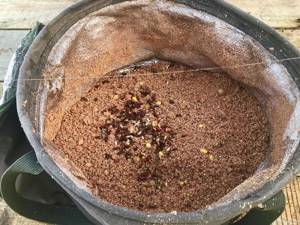
Fishing algorithm and what to do when it doesn’t bite
To begin with, we select a promising point, preferably a shallow area, and find, if possible, an anomaly at the bottom of the reservoir, for example, a drop to depth, a transition of soil, an edge or a step. I recommend stopping at the top of the edge or step, that is, going up to a shallower depth. It will be better if you find several points at once, since in the spring it is not so easy to find fish, but it is worth it.
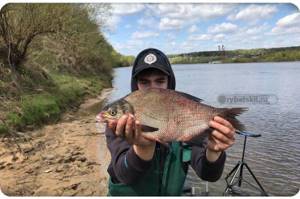
We make a starting feeding and try to catch, if there is no activity at the point within an hour, then we begin to change something, for example, we serve chopped maggots or a worm, dust in the line, change the length of the leash and the thickness of the hook. If the result is not satisfactory, then we try to catch another point.
I want to answer the question “What to do when it doesn’t bite?” My favorite and most effective method is to place a leash one and a half meters, 0.08 in diameter with an 18-20 hook made of thin wire and attach one bloodworm with a ring or stocking. Repeat this operation several times; if there is no bite, then most likely there is no fish at the fishing point or it is extremely passive. And it is also possible that feeding “plugs” of various concentrates and adding dry additives will help. Cocoa, coconut flakes, dry food, crushed bloodworms, and caster often help in such cases.
Feeder equipment
At this point in time, the fishing industry can offer feeder fishing enthusiasts a very large number of all kinds of feeder rods and a variety of equipment for them.
Today there are a lot of feeders of Chinese origin, which are less expensive, although they show good results in fishing. There are many more expensive options for feeder rods, Japanese, American, European, in general, for every color and taste. Each angler decides for himself which feeder rod to use for fishing in early spring.
In most options, the feeder rod is equipped with three different tips, varying in their rigidity. The softest version of the feeder tip is more suitable for fishing in early spring on weak currents; with a medium level of hardness it is more successful when fishing on currents of medium strength. But the toughest option is suitable for fishing in early spring on strong and swift currents. There are, of course, feeders that have many more tips; it is much easier to select bite alarms for such rods.
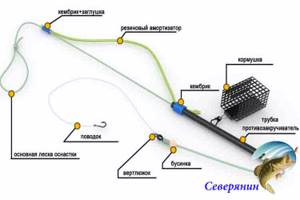
For fishing in reservoirs in early spring, experienced fishermen are advised to select feeder rods, which in their dimensional characteristics will vary from two and a half meters to three and a half meters in length. On larger bodies of water, you can choose a longer rod. Such a feeder will be convenient on heavily overgrown banks, but in this case the pendulum type of casting should be used.
When choosing a reel for such a feeder, anglers are more focused on the options of spinning reels. When fishing in early spring on particularly fast currents, or in those places of the reservoir where there are a lot of stones at the bottom, it is better to use reels with high-speed winding, where the gear ratio is not less than 6:1. The diameter of the spool is selected according to the diametric parameters of the fishing line.
The feeder for the feeder is selected depending on the strength of the current. In fast currents, feeders from 150 to two hundred grams in weight perform better. In this case, the cells on the mesh of the feeder itself should not be too large.
Most often, anglers use monofilament with parameters from 0.35 to 0.45 millimeters to catch fish in reservoirs in early spring. It is these monofilament diameters that make it possible to catch large bream and other types of fish of similar size. Leashes are made from fishing line 0.15 to 0.3 mm, although the greater the weight of the fish that the angler wants to catch, the larger the diameter of the leash line.
When fishing with a feeder, many anglers use baits made from maggots and other worms; they can bait both bloodworms and caterpillars. But at the same time, it was noted that such a bait should be alive and move on the hook, which most of all attracts all types of fish.
What kind of fish is caught on a spring feeder?

When fishing in early spring with a feeder on the river, I most often catch roach. I often run into white bream. Bream or crucian carp caught in the spring on a feeder can be a pleasant bonus. Often you come across very large and untargeted fish, it’s spring after all. A predator can easily fall for bait that is unpromising for him and there is nothing wrong with that. I have noticed many times that in the spring various strange things happen under water.
The most important thing in this fishing is that fish with caviar carries additional qualities, for some they are gastronomic, but I like to release the caviar fish, you release it and understand that you have done a good deed. Caught and released is a good position, but this is everyone’s business and a purely personal one.
Colleagues, thank you for your time, I will be glad to see your feedback. Write your experiences, as sharing experiences is great. Best regards, Anton Timoshin.
Spring feeder fishing
Fishing in the spring on the feeder depends on the time of opening of reservoirs, warming of the water, the onset of floods and the return of the water level to the usual level. These changes occur differently in regions and types of reservoirs. Therefore, we will not be tied to specific calendar dates, but to the peculiarities of fishing depending on the conditions of the area. The spring feeder can be divided into three periods:
Fishing in early spring
- From ice break-up to warming and floods, as well as winter feeder in non-freezing reservoirs. When water bodies just begin to become free of ice, the fish are still passive, and their behavior largely repeats that in winter. Water temperature – no more than 10 degrees.
- In early spring, purely winter feeder tactics are used - dark, finely dispersed non-nutritive baits with the addition of animal components in small quantities, with natural or spicy aromas, neat rigs, fishing in winter moorings for fish with a smooth transition to shallower areas upstream (in the upper reaches of ponds) with warming.
- It is better to try to fish with a feeder in places where the ice melts first, on the current at the exits from the pits, in the water areas at the confluence of warm, non-freezing channels and canals, at the mouths of rivers, where the fish are already gathering for the spring trip.
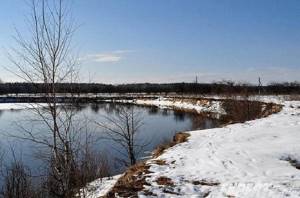
Rising water and flood
- Warming up the water to 10-15 degrees. In mid-spring, large fish follow the flooded small tributaries upstream to spawn. The first to move are fisherman, roach, ide, and bream. Then - crucian carp, chub, more heat-loving fish.
- Small immature fish do not migrate in the spring, remaining in their usual places. The difficulty is that fish may not be found in the old familiar places.
- But in small rivers, tributaries, shallow irrigation areas and flooded meadows in the spring you can catch a full feeder fish if you get to the right place at the right time. The fish also travel along the beds of fairly large rivers, rising from the lower reaches and reservoirs.
- April and May are a time of miracles. In places that are closed in the summer, in the spring you can catch with a feeder many types of different large fish that rise up. The warmer summer sweet aromas and botanicals begin to work.
Recession of the flood
- An increase in water temperature, clearing of water areas, and the beginning of the growth of aquatic vegetation. A real Eldorado for the feeder. You can catch any kind of fish anywhere.
- With the warming and decline of water in the spring, we fish in shallows, in bushes, in small rivers and upper reaches. In large reservoirs in deep holes, the bite will begin when the bream returns there after spawning - closer to June.
- During this period, the fish are active everywhere - you need to find the right keys. In May it bites well and actively on the feeder, the main thing is to sit in the right place. The water is cloudy and the fish are hungry. You don’t have to go too thin with the rigs.
- Bream and fishermen descend, crucian carp rise – different regions have their own characteristics. The active time of spring fishing in open water is coming.
